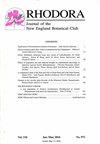Another Successful Establishment of Pawpaw (Asimina triloba, Annonaceae) in Massachusetts
IF 0.2
4区 生物学
Q4 PLANT SCIENCES
引用次数: 0
Abstract
In 2019, the first naturalized population of pawpaw, Asimina triloba (L.) Dunal, in Massachusetts was found by Barbara Katzenberg (Standley and Katzenberg 2019) in Lexington, Massachusetts. In October 2020, Russ Cohen located a second population approximately 1.5 km west of the original, in the Town of Lexington’s Parker Meadow Conservation Area. This population extends across almost 0.8 ha, with stem densities reaching 30 per square meter. Numerous trees are 8 to 10 cm in diameter and 6 to 7 m tall. Ripening fruits were present on the larger trees and on the ground. There are several disjunct clusters of stems, separated by up to 15 m of woods and trails. These discrete clusters are likely to represent separate clones resulting from independent seedling establishment. Plants were observed in undisturbed woods, open wet woods, and on a linear dredge spoil pile. The character of this newly discovered naturalized pawpaw patch, in terms of the size, density, and distribution of the plants present, growing underneath a canopy of taller trees, compares very favorably to naturally occurring populations of this species Cohen has observed in its native range further south (e.g., the Ohio River Valley). The origin of this naturalized population more than 200 miles from the natural range limit in western New York and northern Pennsylvania (Kral 1997) is unknown, likely human-mediated seed or seedling establishment from a cultivated source. Pawpaw has been cultivated at the Arnold Arboretum since 1880 (Arnold Arboretum 2021) and is known to us to be cultivated at other locations in Middlesex County. The presence of multiple clones of different ages at this location suggests successful sexual reproduction and short-distance seed dispersal by natural agents, perhaps coyotes, as documented by Cypher and Cypher (1999). The extensive spread and apparent recruitment from seed of pawpaw at this suburban Boston location suggests that increasingly temperate conditions brought on by climate change are favorable to vegetative and sexual reproduction of more southerly species such as Asimina triloba and allow them to occupy New England habitats, including natural woodlands (see also Bellemare and Deeg 2015). Using bioclimatic modelling,马齿苋(番荔枝科,三叶亚属)在马萨诸塞州的另一个成功建立
2019年,Barbara Katzenberg(Standley和Katzenberg,2019)在马萨诸塞州列克星敦发现了马萨诸塞州的第一个木瓜归化种群Asimina triloba(L.)Dunal。2020年10月,Russ Cohen在Lexington镇的Parker Meadow保护区发现了第二个种群,位于原始种群以西约1.5公里处。该种群面积近0.8公顷,树干密度达到每平方米30棵。许多树的直径在8到10厘米之间,高在6到7米之间。大树和地上都结着成熟的果实。有几个不连续的茎丛,被长达15米的树林和小径隔开。这些离散的聚类可能代表独立幼苗建立后产生的独立克隆。在未受干扰的树林、开阔的潮湿树林和线性疏浚弃土堆上观察到植物。就生长在较高树冠下的植物的大小、密度和分布而言,这个新发现的归化木瓜斑块的特征与科恩在其更南的原生范围(例如俄亥俄河谷)观察到的该物种的自然种群相比非常有利。这种归化种群的起源距离纽约西部和宾夕法尼亚州北部的自然范围限制200多英里(Kral 1997),目前尚不清楚,可能是人类介导的从栽培来源建立种子或幼苗。Pawpow自1880年以来一直在Arnold植物园种植(Arnold Arboretum 2021),我们知道它在米德尔塞克斯县的其他地方也有种植。正如Cypher和Cypher(1999)所记录的那样,在这个位置存在多个不同年龄的克隆表明,自然媒介(可能是郊狼)成功地进行了有性繁殖和短距离种子传播。在波士顿郊区的这个地方,木瓜种子的广泛传播和明显的补充表明,气候变化带来的日益温和的条件有利于更偏南物种的营养繁殖和有性繁殖,如三角叶木瓜,并使它们能够占据新英格兰的栖息地,包括天然林地(另见Bellemare和Deeg 2015)。使用生物气候建模,
本文章由计算机程序翻译,如有差异,请以英文原文为准。
求助全文
约1分钟内获得全文
求助全文
来源期刊

Rhodora
生物-植物科学
CiteScore
0.40
自引率
0.00%
发文量
40
审稿时长
>12 weeks
期刊介绍:
This peer-reviewed journal is devoted primarily to the botany of North America and accepts scientific papers and notes relating to the systematics, floristics, ecology, paleobotany, or conservation biology of this or floristically related regions.
 求助内容:
求助内容: 应助结果提醒方式:
应助结果提醒方式:


